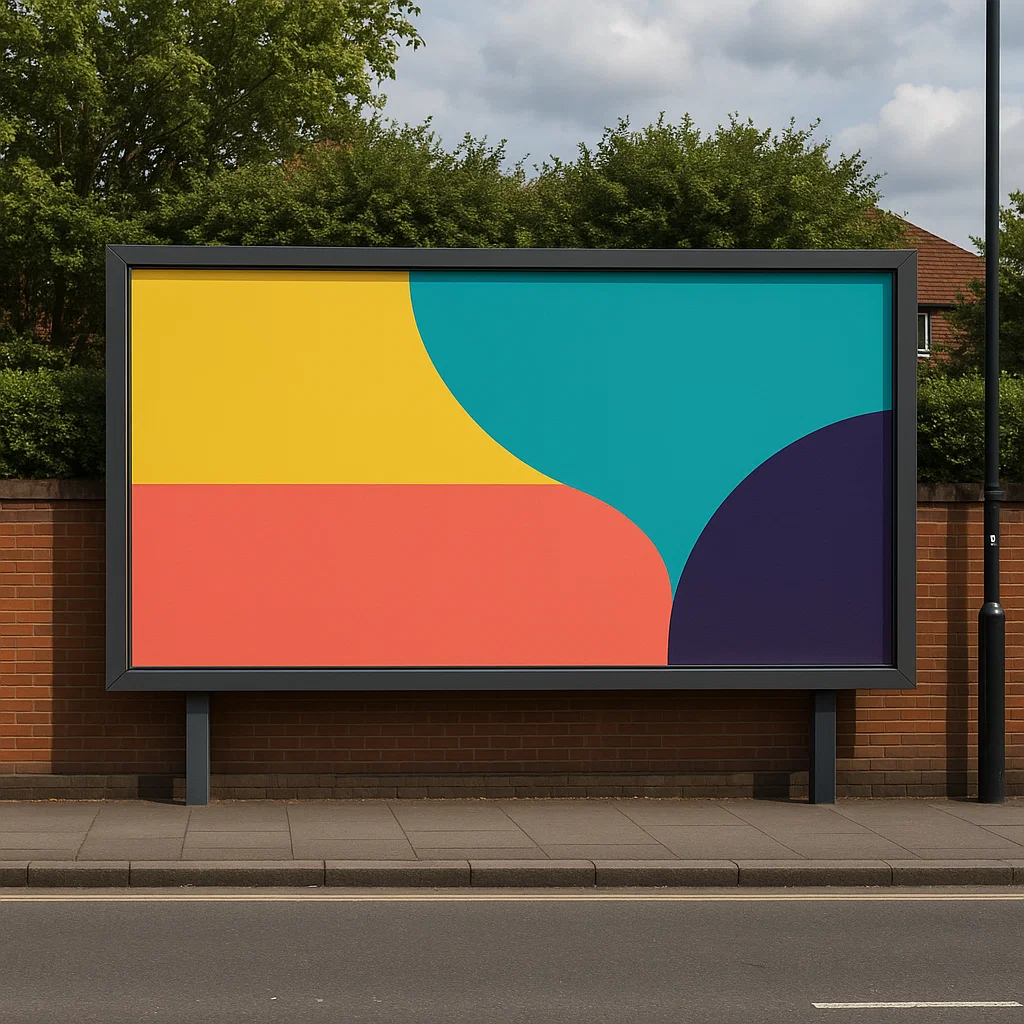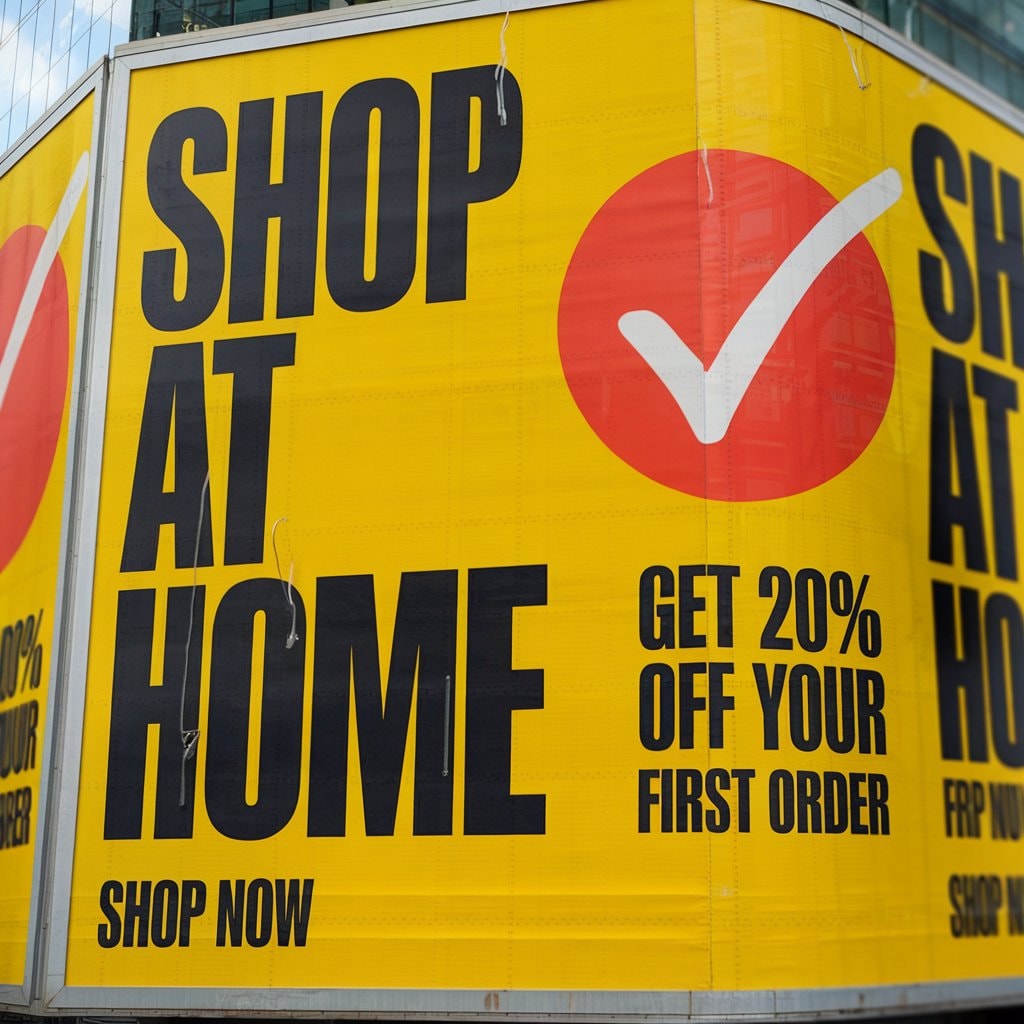Effective Types of Outdoor Hoarding Advertising to Promote Your Brand
Effective outdoor hoarding advertising to promote your brand includes digital billboards, backlit hoardings, and large-scale banner ads, each offering visibility and dynamic content adaptability. Strategic placements in high-traffic areas maximise brand exposure and audience engagement. Utilising these hoardings with carefully tailored messages and creative designs can significantly elevate a brand’s presence in competitive markets. Further exploration is recommended for deeper insight into maximising the impact of these advertising strategies.
What is Hoarding Advertising?
Hoarding advertising is a distinct form of outdoor marketing that utilises large panels typically installed in high-traffic areas to maximise visibility and impact.
Unlike other advertising mediums, hoardings offer the advantage of scale and permanence, providing continual exposure to a diverse audience.
This method shapes brand presence and consumer perceptions in the outdoor advertising landscape.
Understanding the Concept of Hoarding Advertising
Although often overlooked in the digital age, hoarding advertising remains a powerful marketing tool, strategically capturing the attention of large audiences in public spaces. This advertising leverages large panels in high-traffic areas, such as construction sites, to promote brands effectively.
Here are the key aspects:
- Maximised Brand Visibility: Advertising hoardings in busy areas guarantee high brand exposure.
- Creative Freedom: Hoarding advertising offers vast space for innovative, eye-catching designs that capture attention.
- Sustained Exposure: Unlike digital ads, construction hoarding provides a prolonged brand presence, allowing for continuous audience engagement.
Analysing these elements reveals how hoarding advertising is essential in boosting brand awareness and visibility through strategic placement and creative execution.
How Hoarding Differs from Other Forms of Advertising
Building on the understanding of hoarding advertising as a unique promotional tool, it is enlightening to compare its characteristics with other advertising methods.
Unlike digital marketing strategies that often target specific user profiles, hoarding advertising delivers constant exposure to a diverse audience. This advertising leverages significant, static displays strategically placed in high-traffic areas, ensuring brand messages reach a broad public segment.
While digital billboards offer dynamic content, traditional hoardings provide a constant presence that fortifies brand awareness through repeated exposure.
In addition, as an “out of home” advertising medium, hoardings are not limited by internet accessibility, making them a reliable choice in reaching a target audience across various demographics, unlike some forms of digital advertising.
The Role of Advertising Hoardings in Outdoor
Several businesses harness the power of advertising hoardings to enhance their visibility in the bustling outdoor landscape.
Outdoor hoarding advertising, strategically placed in high-traffic areas, is critical for creating brand awareness and maximising brand exposure. For those new to this medium, exploring a comprehensive guide to outdoor signage for businesses can provide clarity on how hoardings fit within broader marketing strategies.
Here’s how they impact:
- Strategic Placement: Placed at strategic locations, including main roads, city centres, and nearby landmarks, these advertising panels capture the attention of a diverse audience.
- Size and Visibility: The large size of billboard advertising guarantees visibility from a distance, making an impactful brand statement that is hard to miss.
- Continuous Exposure: Unlike digital ads that flash by, construction hoardings offer continuous exposure, keeping the brand in public view 24/7, thereby embedding the brand deeper into the consumer’s daily environment.
Types of Hoarding Advertising
Exploring the types of hoarding advertising reveals strategic insights into consumer engagement and brand visibility.
Construction site hoardings, for instance, secure sites and offer a significant canvas for impactful advertising to passersby.
Analysing the most popular types of hoarding ads can guide businesses in choosing the most effective approach to reach their target audience.

The Significance of Construction Site Hoardings
Construction site hoardings serve as a powerful platform in outdoor advertising, strategically transforming the ubiquitous barriers around building sites into enchanting visual narratives.
These hoardings not only act as a safety barrier but also offer a unique promotional display opportunity during the lifecycle of a construction project.
Analysing their impact reveals several key advantages:
- Brand Visibility: Hoarding panels provide large-scale exposure in high-traffic areas, amplifying brand presence considerably.
- Cost-Effectiveness: Compared to other forms of advertising, hoarding advertising costs are relatively low, offering prolonged exposure for a one-time investment.
- Targeted Advertising: Hoarding advertisers learn to tailor messages that resonate with the area’s demographics, enhancing the relevance and impact of display advertisements surrounding a building project.
What Are the Most Popular Types of Hoarding Advertising?
Having established the importance of construction site hoardings as a valuable advertising medium, examining the various forms this advertising can take is pertinent. Among the most prevalent types of hoarding advertising are backlit and front-lit hoardings.
These illuminated outdoor structures in high-traffic areas are particularly effective for creating impactful visual impressions day and night. Backlit hoardings offer the advantage of visibility in low-light conditions, making them prime choices for continuous exposure.
Frontlit hoardings, on the other hand, are illuminated from the front, enhancing colour vibrancy and clarity. Both types are integral to successful hoarding advertising campaigns, strategically transforming ordinary construction sites into dynamic displays mounted to capture and engage a diverse audience effectively.
Benefits of Hoarding Advertising for Brands: Exposure
Hoarding advertising stands as a pivotal strategy for enhancing brand visibility, particularly effective in high-traffic areas where it garners significant exposure.
Compared to other advertising mediums, hoardings’ cost-effectiveness offers brands a financially viable option with substantial reach.
Consequently, advertisers frequently opt for billboard advertising to strategically embed their brands in consumers’ minds, maximising impact and recall.
How Hoarding Advertising Boosts Brand Awareness
Effective hoarding advertising is a powerful catalyst for enhancing brand visibility and recognition among diverse audiences. Through its strategic placement and design, this type of outdoor hoarding advertising agency taps into the vast potential of public spaces to capture the attention of passersby.
Here are three key benefits:
- Extended Reach: Large-scale advertisements displayed in high-traffic areas guarantee the brand message reaches a broad audience, maximising visibility.
- Brand Reinforcement: With repeated exposure, hoardings help build brand awareness, keeping the brand continuously visible and top of mind.
- Immediate Impact: The sheer size and bold visuals of hoarding ads grab attention swiftly, promoting products effectively and persuasively, thereby enhancing the overall effectiveness of hoarding advertising.
Cost Effective of Hoarding Advertising
A significant advantage of hoarding advertising is its cost-effectiveness compared to other media platforms. By leveraging lower advertising rates, brands can sustain their presence in high-traffic areas, ensuring continuous visibility.
This strategic placement in a dynamic advertising environment allows brands to reach a large audience without the hefty price tag often associated with digital or broadcast media. The cost-effectiveness of hoarding advertising enhances brand recognition and multiplies advertising opportunities.
With maximum visibility, these outdoor advertisements constantly remind potential consumers, reinforcing brand messages effectively. Analytically, the return on investment for hoarding advertising often surpasses other advertising mediums due to its broad reach and persistent presence in the consumer’s daily landscape.
Why Advertisers Choose Billboard Advertising for High-Traffic Areas
Advertisers often opt for billboard advertising in high-traffic areas due to its unparalleled capacity to capture audience attention. This outdoor advertising strategically leverages prominent locations to maximise brand exposure.
The distinct advantages include:
- Unmatched Visibility: Placed in high-traffic areas, billboards capture the attention of drivers and pedestrians alike, ensuring that a brand’s message reaches a large audience.
- Flexibility in Content: Billboards allow advertisers to update content according to market trends or promotional needs, keeping the messaging relevant and engaging.
- Strategic Placement: Advertising agencies expertly select locations that are high in traffic and relevant to the target demographic, enhancing the efficacy of the advertising campaign and increasing brand recognition.
Exploring Different Types of Hoarding Advertising
As the landscape of outdoor advertising evolves, understanding the distinctions and enduring appeal of various hoarding types becomes essential for strategic marketing.
Analysing why billboard hoardings remain dominant reveals insights into consumer behaviour and visibility effectiveness.
In addition, exploring the technical and visual impact differences between backlit, front-lit, and digital billboards can guide advertisers in optimising their investment for maximum audience engagement.
Billboard Hoardings: Why Are They Still So Popular?
Despite the surge in digital marketing, billboard hoardings remain a cornerstone of advertising strategies due to their unparalleled visibility and broad reach. Positioned strategically in high-traffic areas, these large-scale structures are crafted to attract the attention of a wide range of audiences, promoting brands effectively through eye-catching displays and hoarding graphics.
- High Visibility: Billboards are typically illuminated from the front, ensuring they are always visible, which helps maximise brand exposure.
- Strategic Placement: Their placement in high-traffic areas guarantees that messages reach a large audience spanning varied demographics.
- Impactful Design: The scale and design of billboard hoardings make them more memorable, solidifying brand presence in the minds of consumers through effective outdoor hoarding advertising.
Backlit and Frontlit Hoardings: What’s the Difference?
Understanding the distinctions between backlit and frontlit hoardings is vital for advertisers seeking to optimise their effective outdoor advertising types.
Backlit hoardings, illuminated from behind, offer enhanced visibility, especially at night, creating a vibrant and visually appealing display that can grab attention in high-traffic areas. This type is advantageous for promotional purposes where round-the-clock impact is essential.
On the other hand, front-lit hoardings are illuminated from the front, typically with spotlights. While they also enhance visibility, they depend more on external lighting conditions.
Analysing these types and advantages allows advertisers to deploy strategic advertising strategies that utilise each other’s strengths to maximise outreach and consumer engagement.
Both styles guarantee your message stands out, but the choice depends on specific campaign goals and location characteristics.
How Do Digital Billboards Differ from Traditional Billboards?
- Technological Advancement: Digital billboards embody the constantly evolving nature of advertising media. Unlike traditional billboards, which typically feature static images, digital billboards can display dynamic content that changes throughout the day, making them more engaging and capable of delivering multiple messages.
- Visibility and Impact: Digital billboards are large and often strategically placed to capture passersby’s attention in high-traffic areas. Their bright, eye-catching displays, which can be illuminated much like frontlit hoardings, guarantee advertisements are visible day and night.
- Flexibility in Content Management: Digital billboards offer the unique advantage of allowing advertisers to update content remotely and swiftly, which is vital for time-sensitive promotions and reactive advertising campaigns.
This flexibility is not feasible with traditional billboards, where each change requires physically replacing the displayed advertisements.
Hoarding Advertising in the UK: A Growing Trend
In the UK’s bustling urban landscapes, hoarding advertising has distinctly increased, signalling a dynamic shift in urban marketing strategies.
Advertisers, however, face significant challenges, including stringent regulatory frameworks and high competition for prime advertising spaces.
These factors compel a strategic reevaluation of traditional advertising approaches, emphasising the sector’s need for innovation and adaptability.
The Rise of Hoarding Advertising in UK Cities
The reason is its unique advantages in densely populated urban environments.
Here are three primary factors:
- Visibility in High-Traffic Areas: Hoarding is a large outdoor advertising format that captures a huge audience’s attention daily. Its size and prominence in strategic locations make it highly effective for brands aiming to promote products.
- Community Engagement: Engaging the local community with hoardings frequently seen outdoors becomes more straightforward. They serve as landmarks and conversation starters, enhancing community ties.
- Scalable Impact: The size of the hoarding allows for creative, large-scale advertisements that are more memorable. This scalability makes hoardings a preferred choice for impactful advertising in urban settings.
Challenges Faced by Advertisers in the UK
Despite the growing popularity of hoarding advertising in urban centres across the UK, advertisers face notable challenges that may hinder the success of their campaigns.
In an increasingly digital age, hoardings often feature celebrities to capture the diverse audience’s attention. However, negotiating competitive rates for prime locations, such as shopping centres, becomes arduous due to smaller outdoor spaces and the saturation of many hoarding advertisements.
Factors such as location considerably influence visibility and audience reach, making strategic placement essential for a cost-effective way to engage a broad audience.
Furthermore, the shift towards digital platforms demands continuous innovation in hoarding designs to remain engaging, thereby adding another layer of complexity to maintaining campaign effectiveness in dynamic urban environments.
Understanding the Costs of Hoarding Advertising
Evaluating the expenses associated with hoarding advertising is vital for marketers aiming to maximise return on investment.
Various factors significantly impact overall costs, including location, size, and advertisement duration.
To effectively allocate resources, businesses must strategically plan their budgets, considering these key elements to optimise their advertising campaigns.

Factors Influencing Hoarding Advertising Costs
Understanding the factors influencing the costs of hoarding advertising is crucial for businesses looking to optimise their marketing budget.
Here are three key considerations:
- Location and Visibility: Prime spots with high traffic guarantee greater visibility and, therefore, higher costs. Proximity to major roads or commercial hubs directly impacts brand promotion effectiveness through outdoor hoarding advertising.
- Size of Hoarding and Duration of Campaign: Larger hoardings capture more attention but cost more. Similarly, the longer a campaign runs, the more it will cost. Balancing the size with the campaign duration can optimise advertising costs.
- Material Used and Design Complexity: High-quality materials and intricate designs increase production costs. Strategic decisions about materials and simplicity of design can control expenditure without compromising the impact.
Budgeting for a Hoarding Advertising Campaign
When planning a hoarding advertising campaign, it is essential for marketers to meticulously budget for various expenses to guarantee both financial control and campaign effectiveness.
Budgeting for a hoarding advertising campaign involves understanding the cost of multiple sheets and ensuring the advertisement reaches potential customers. The usual locations for hoardings offer an interesting combination of high traffic visibility and demographic targeting, which plays a critical role in executing the most innovative advertising campaigns.
Marketers should analyse key cost features, including size, duration, and design complexity. This strategic approach not only enhances the campaign’s impact but also maximises return on investment by highlighting the benefits and examples of successful, cost-effective placements.
Conclusion
To sum up, hoarding advertising is a pivotal strategy for brand promotion, offering diverse types and substantial visibility. The UK market shows a promising increase in its adoption, affirming its effectiveness. Brands considering this method should analyse the options and associated costs to leverage hoardings for maximum strategic exposure. Businesses can enhance their market presence, resonate with broader audiences, and achieve a significant competitive edge in today’s dynamic business environment.


